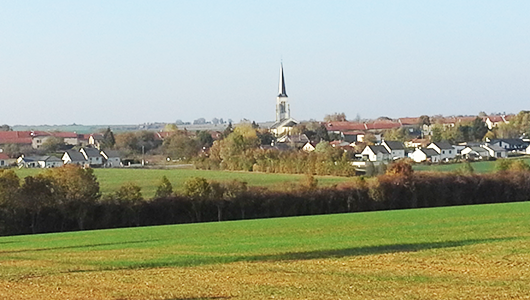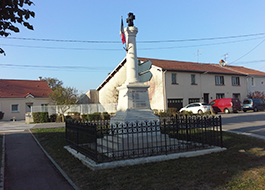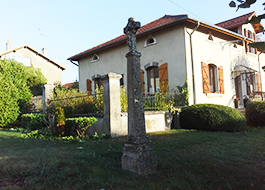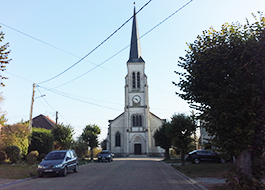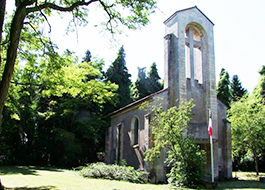Limey-Remenauville
Durée visite : 40 minutes
Moyen : Pédestre
Il s’agit de deux villages rattachés. Remenauville comptait 138 habitants avant 1914. Occupé par l’armée allemande dès septembre 1914, il sera sur la ligne de front pendant quatre ans. Il ne fut libéré qu’en septembre 1918, lors de l’offensive franco-américaine contre le saillant de Saint-Mihiel. Le village est entièrement détruit.Son emplacement est désormais couvert par la végétation. Des sentiers ont été créés sur d’anciennes rues, indiquées par un panneau avec la position des principales maisons. Une chapelle a été construite à l’endroit de l’ancienne église. En effet, les habitants de Remenauville ne voulurent pas reconstruire leur village de crainte d’une nouvelle destruction. Ils sont rattachés depuis 1942 à Limey. Avec 80% de son bâti détruit en 1914-18, Limey est reconstruit par l’architecte nancéien Emile André, membre de l’école de Nancy. Le village possède certaines particularités. Plusieurs maisons présentent des fenêtres de grange, symbolisant les quatre signes des jeux de cartes. Des maisons dites de maître, avec d’immenses écuries habitables, comptent parmi les plus belles demeures de la région. Deux lettres, à côté de leur entrée, indiquent le nombre d’officiers, d’hommes et de chevaux, qu’elles pouvaient abriter pendant la guerre.
These are two attached villages. Remenauville had 138 inhabitants before 1914. Occupied by the German army from September 1914, it will be on the front line for four years. He was not released until September 1918, during the Franco-American offensive against the Saint-Mihiel salient. The village is completely destroyed and its location is now covered by vegetation. Paths have been created on ancient streets, indicated by a sign with the position of the main houses. A chapel was built on the site of the old church. Indeed, the inhabitants of Remenauville did not want to rebuild their village for fear of further destruction. They have been attached to Limey since 1942. With 80% of its buildings destroyed in 1914-18, Limey was rebuilt by the Nancy architect Emile André, a member of the Nancy school. The village has certain peculiarities. Several houses feature barn windows symbolizing the four signs of the card games.So-called mansions, with huge living stables, are among the most beautiful homes in the region. Two letters, next to their entrance, indicate the number of officers, men and horses, which they could shelter during the war.
Dies sind zwei angeschlossene Dörfer. Remenauville hatte vor 1914 138 Einwohner. Ab September 1914 von der deutschen Armee besetzt, wird es vier Jahre lang an vorderster Front stehen. Er wurde erst im September 1918 während der französisch-amerikanischen Offensive gegen den herausragenden Saint-Mihiel freigelassen. Das Dorf ist vollständig zerstört und seine Lage ist jetzt von Vegetation bedeckt. Auf alten Straßen wurden Wege angelegt, die durch ein Schild mit der Position der Haupthäuser gekennzeichnet sind. An der Stelle der alten Kirche wurde eine Kapelle errichtet. In der Tat wollten die Einwohner von Remenauville ihr Dorf aus Angst vor weiterer Zerstörung nicht wieder aufbauen. Sie sind seit 1942 an Limey gebunden. Nachdem zwischen 1914 und 18 80% der Gebäude zerstört worden waren, wurde Limey vom Nancy-Architekten Emile André, einem Mitglied der Nancy-Schule, wieder aufgebaut. Das Dorf hat gewisse Besonderheiten. Einige Häuser verfügen über Scheunenfenster, die die vier Zeichen der Kartenspiele symbolisieren.Sogenannte Villen mit riesigen Wohnställen gehören zu den schönsten Häusern der Region. Zwei Buchstaben neben ihrem Eingang geben die Anzahl der Offiziere, Männer und Pferde an, die sie während des Krieges schützen konnten.

D’argent à l’orme de sinople à la bordure de même.
Il s’agit d’armes parlantes. En effet Dauzat donne comme étymologie au nom de Limeil, Limeuil, Limey : la clairière des ormes. L’orme entouré d’une bordure se trouve dans une clairière.
Argent to the elm Vert on the border of the same.
These are talking weapons. Indeed Dauzat gives as etymology to the name of Limeil, Limeuil, Limey: the clearing of elms. The elm surrounded by a border is in a clearing.
Argent zur Ulme Vert an der Grenze desselben.
Das sind sprechende Waffen. In der Tat gibt Dauzat dem Namen Limeil, Limeuil, Limey als Etymologie: das Löschen von Ulmen. Die von einer Grenze umgebene Ulme befindet sich auf einer Lichtung.

Les habitants de Limey-Remenauvile s’appellent les Liméens et les Liméennes.
The inhabitants of Limey-Remenauvile are called the Liméens and the Liméennes.
Die Einwohner von Limey-Remenauvile heißen Liméens und Liméennes.
Les points de visites
.
Cette colonne sur socle est surmontée d’une croix de guerre. A côté des enfants de Limey tués au combat, figurent les noms des Liméens et Liméennes décédés en exil. Une plaque est dédiée, chose rare sur ce type de mémorial, aux troupes françaises et américaines ayant combattu dans la région. La 73ème Division d’infanterie a bataillé à Fey-en-Haye et Bois-le-Prêtre en 1914 et 1915. La 65ème est active ici à l’été 1918. Les soldats US se sont illustrés dans la réduction du Saillant de Saint-Mihiel.
This column on a base is surmounted by a war cross. Next to the children of Limey killed in action, appear the names of the Limeans and Limeans who died in exile. A plaque is dedicated, a rare thing on this type of memorial, to French and American troops who fought in the region. The 73rd Infantry Division battled at Fey-en-Haye and Bois-le-Prêtre in 1914 and 1915. The 65th is active here in the summer of 1918. US soldiers distinguished themselves in the reduction of the Saillant de Saint- Mihiel.
Diese Säule auf einer Basis wird von einem Kriegskreuz überragt. Neben den Kindern von Limey, die in Aktion getötet wurden, erscheinen die Namen der Limeaner und Limeaner, die im Exil starben.Eine Plakette ist, eine seltene Sache auf dieser Art von Denkmal, französischen und amerikanischen Truppen gewidmet, die in der Region kämpften. Die 73. Infanteriedivision kämpfte 1914 und 1915 in Fey-en-Haye und Bois-le-Prêtre. Die 65. ist hier im Sommer 1918 aktiv. US-Soldaten zeichneten sich durch die Reduzierung des Saillant de Saint-Mihiel aus.
.
.
La croix de chemin est un symbole religieux catholique très répandu du 16e siècle à nos jours. Elles sont dues à la volonté publique des communautés ou celle privée des familles. Les premières agrémentent les bourgs et les hameaux et symbolisent l’acte de foi de la communauté. On les rencontre souvent aux carrefours, elles guident le voyageur et le protègent de l’inconnu et des mauvaises rencontres. Elles sont parfois un lieu de pèlerinage. Les secondes sont érigées à la suite d’une initiative privée, souvent par une famille aisée qui voulait à la fois affirmer sa foi, protéger les siens, obtenir une faveur ou en signe de reconnaissance si celle-ci était obtenue.
The railway cross is a widely used Catholic religious symbol from the 16th century to the present day. They are due to the public will of communities or the private will of families. The first embellish the towns and hamlets and symbolize the community’s act of faith. We often meet them at crossroads, they guide the traveler and protect him from the unknown and bad encounters. They are sometimes a place of pilgrimage. The latter are erected as a result of a private initiative, often by a wealthy family who wanted to both affirm their faith, protect their family, obtain a favor or as a sign of recognition if it were obtained.
Das Eisenbahnkreuz ist vom 16. Jahrhundert bis heute ein weit verbreitetes katholisches religiöses Symbol. Sie sind auf den öffentlichen Willen der Gemeinschaften oder den privaten Willen der Familien zurückzuführen. Die ersten verschönern die Städte und Weiler und symbolisieren den Glaubensakt der Gemeinde. Wir treffen sie oft an Kreuzungen, sie führen den Reisenden und schützen ihn vor unbekannten und schlechten Begegnungen. Sie sind manchmal ein Wallfahrtsort. Letztere werden als Ergebnis einer privaten Initiative errichtet, oft von einer wohlhabenden Familie, die sowohl ihren Glauben bekräftigen, ihre Familie schützen, einen Gefallen erlangen oder als Zeichen der Anerkennung, wenn er erlangt wurde.
.
L’église de la Nativité-de-la-Vierge a été reconstruite après 1918 en style néo-gothique. Ce style architectural, nostalgique de l’époque médiévale, est né au milieu du 18e siècle en Angleterre. Il y a peut-être eu davantage d’architecture gothique construite aux 19e et 20e siècles qu’à la fin du Moyen Âge et au début de la Renaissance. Les vitraux sont signés Jacques Grüber. Maître verrier et ébéniste, cofondateur en 1901 de l’Ecole de Nancy, il est l’auteur de nombreuses œuvres dans cette ville. Citons les vitraux des villas Majorelle et Bergeret. On lui doit la grande verrière des Galeries Lafayette à Paris. Il est l’auteur des vitraux de l’église de Fey-en-Haye.
The Church of the Nativity of the Virgin was rebuilt after 1918 in neo-Gothic style. This architectural style, nostalgic for medieval times, was born in the middle of the 18th century in England. There may have been more Gothic architecture built in the 19th and 20th centuries than in the late Middle Ages and early Renaissance. The stained glass windows are signed Jacques Grüber. Master glassmaker and cabinetmaker, co-founder in 1901 of the School of Nancy, he is the author of many works in this city. Let us quote the stained glass windows of the Majorelle and Bergeret villas. We owe him the large glass roof of the Galeries Lafayette in Paris. He is the author of the stained glass windows for the church of Fey-en-Haye.
Die Geburtskirche der Jungfrau wurde nach 1918 im neugotischen Stil wieder aufgebaut. Dieser für das Mittelalter nostalgische Baustil wurde Mitte des 18. Jahrhunderts in England geboren. Möglicherweise wurde im 19. und 20. Jahrhundert mehr gotische Architektur erbaut als im Spätmittelalter und in der frühen Renaissance. Die Glasfenster sind mit Jacques Grüber signiert. Glasmacher- und Tischlermeister, 1901 Mitbegründer der School of Nancy, Autor zahlreicher Werke in dieser Stadt. Lassen Sie uns die Buntglasfenster der Villen Majorelle und Bergeret zitieren. Wir schulden ihm das große Glasdach der Galeries Lafayette in Paris. Er ist der Autor der Buntglasfenster für die Kirche von Fey-en-Haye.
.
Durant la première guerre mondiale, tout comme le village, l’église de Réménauville, datant de 1862, fut détruite. Dans les années1930, une chapelle commémorative a été construite sur les ruines même du choeur de l’ancienne église paroissiale. Remarquez le gisant sous l’autel. La stèle du souvenir se trouve à droite du portail. Elle est dédiée aux enfants de la commune morts en 14-18.
During the First World War, like the village, the church of Réménauville, dating from 1862, was destroyed. In the 1930s, a memorial chapel was built on the very ruins of the choir of the old parish church. Notice the lying under the altar. The memorial stele is to the right of the portal. It is dedicated to the children of the town who died in 14-18.
Während des Ersten Weltkriegs wurde wie das Dorf die Kirche von Réménauville aus dem Jahr 1862 zerstört. In den 1930er Jahren wurde auf den Ruinen des Chores der alten Pfarrkirche eine Gedenkkapelle errichtet. Beachten Sie das Liegen unter dem Altar. Die Gedenkstele befindet sich rechts vom Portal. Es ist den Kindern der Stadt gewidmet, die zwischen 14 und 18 Jahren starben.

